Green Chemistry: Teaching for a Sustainable Future
From Kate Anderson
 Chemistry, the study of matter, has improved our quality of life and made thousands of products possible. Unfortunately, this achievement has come at a price: human health and the environment have been impacted by the unintended consequences of traditional chemistry. We are well aware of many environmental problems facing the planet, but why do we have these problems and what is being done to create a more sustainable world? Chemistry, the study of matter, has improved our quality of life and made thousands of products possible. Unfortunately, this achievement has come at a price: human health and the environment have been impacted by the unintended consequences of traditional chemistry. We are well aware of many environmental problems facing the planet, but why do we have these problems and what is being done to create a more sustainable world?
Green chemistry is the science of creating safe, energy efficient, and non-toxic processes and products that provide sustainable solutions for the environmental problems facing our society today.
Beyond Benign is a non-profit organization working to revolutionize the way chemistry is taught globally by advocating that green chemistry become an integral part of chemistry education. Our mission is to support all educators, scientists, and citizens globally with the scientific tools required to teach and practice green chemistry in order to create a sustainable future. With the global market for green chemistry projected to grow from $11 billion in 2015 to nearly $100 billion by 2020, there is ample opportunity for students to pursue careers in the field.
In working towards this mission, we offer a variety of programs and initiatives to engage individuals in the learning and practicing of green chemistry. Our Teacher-Training Institutes provide K-12 science teachers with the skills and tools to implement green chemistry in their classrooms through 1-day, 3-day and online training. Our curriculum resources include over 175 lessons plans and units focused on green chemistry and related subjects. All curricula is open-access via our website and may be downloaded free of charge. The materials are designed for teachers, by teachers and are linked to state and national standards.
Beyond Benign is also the founder of the Green Chemistry Commitment, a higher education consortium program that unites the green chemistry community around shared goals and a common vision to expand and share green chemistry resources, grow the network of green chemists at universities, improve connections between industry and job opportunities, and to affect systematic and lasting change in chemistry education.
Since its founding in 2007, Beyond Benign has reached 20,000 students, teachers, and community members, trained 2,225 K-12 teachers and mentored 180 college outreach fellows, and united 29 colleges and universities through the Green Chemistry Commitment. For additional information and resources, please visit www.beyondbenign.org and www.greenchemistrycommitment.org.
Kate Anderson is Director of Education at the Beyond Benign Foundation.
Back to newsletter |